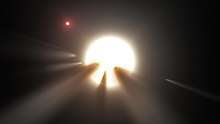K2-21b
K2-21b, also known as EPIC 206011691 b is an exoplanet orbiting K2-21, a red dwarf 273.5 light-years away from Earth,[3] with a period of 9.3 days.[2][4] It has a density of 2.7g/cm3, indicating that it is not a rocky planet.[2] The margin of error is however quite large, with a possible density between 1.1 and 6.4 g/cm3. Due to this error margin, the true nature of its composition is uncertain.
| Discovery[1] | |
|---|---|
| Discovery site | Kepler Space Observatory |
| Discovery date | 2015 |
| Transit | |
| Orbital characteristics | |
| 0.0731 AU (10,940,000 km) | |
| Eccentricity | null[2] |
| 9.32414[2] d | |
| Inclination | 88.3+1.3 −1.1[2] |
| Star | K2-21 |
| Physical characteristics | |
Mean radius | 1.59+0.42 −0.44[2] R⊕ |
| Mass | null[2] M⊕ |
Mean density | 2.7+3.7 −1.6 g cm−3 |
| Temperature | 500 K (227 °C; 440 °F) |
References
- Petigura, Erik A.; et al. (2015). "Two Transiting Earth-Size Planets Near Resonance Orbiting a Nearby Cool Star". The Astrophysical Journal. 811 (2): 102. arXiv:1507.08256. Bibcode:2015ApJ...811..102P. doi:10.1088/0004-637X/811/2/102.
- "K2-21 b CONFIRMED PLANET OVERVIEW PAGE". NASA Exoplanet Archive. Retrieved 2015-10-14.
- Brown, A. G. A.; et al. (Gaia collaboration) (August 2018). "Gaia Data Release 2: Summary of the contents and survey properties". Astronomy & Astrophysics. 616. A1. arXiv:1804.09365. Bibcode:2018A&A...616A...1G. doi:10.1051/0004-6361/201833051. Gaia DR2 record for this source at VizieR.
- http://exoplanet.eu/catalog/epic-206011691_b/
This article is issued from Wikipedia. The text is licensed under Creative Commons - Attribution - Sharealike. Additional terms may apply for the media files.


